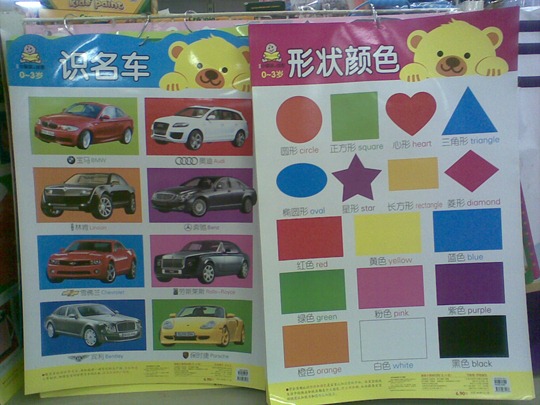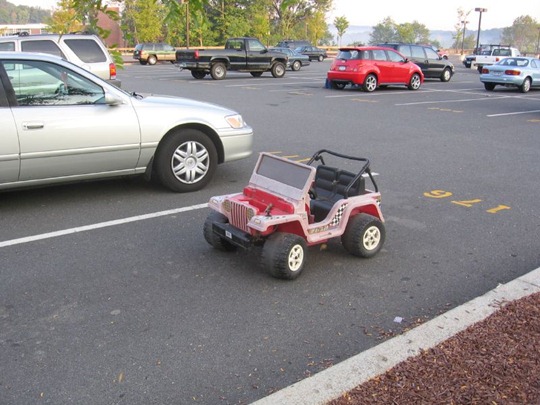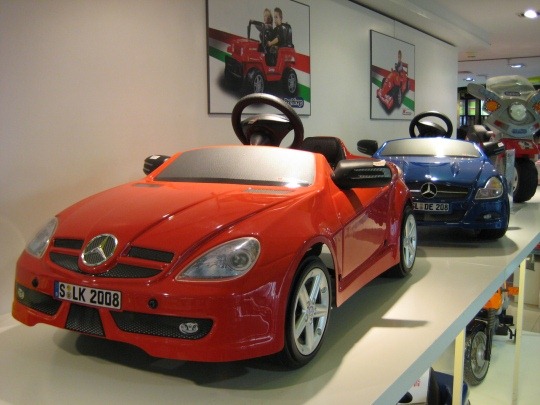Photo “Toy Cars” courtesy of Andrew Dai
In North America, everywhere you look car manufacturers are trying to entice you to buy their brand. Car ads are absolutely everywhere. It’s part of our culture and you can’t avoid it – our society is brainwashed to have an affection for automobiles.
As a kid, I distinctly recall the pride and joy in my father’s eyes when he bought his first new car – a grey 1985 Ford Thunderbird. I remember that first drive we went on, and how he had to buckle me in the back with his pants belt because the car only came equipped with 2 seatbelts in the back (there were 3 of us).
Overseas, the same virus is sweeping over Asia. In China, children are being introduced to luxury car brands at a very young age through educational materials.
Photo courtesy of Patrick Chovanec
It’s hard to eradicate the indoctrination of the automobile marketing machines; especially when they reach you at a very early age. The first 7 or so years of our lives are the most important development years that will shape us for the rest of our lives.
As a kid growing up, most of my hobbies involved cars. From my “dinky cars”, to model cars, to sandbox trucks, to the Power Wheels jeep that I always wanted – but only the rich kids seemed to get.
Photo by Will White
Over the years, those Power Wheels cars have evolved. Check out these stylish Mercedes SLK roadsters for kids being sold in China:
Photo courtesy of Patrick Chovanec
What kid growing up in this environment wouldn’t be looking forward to driving a car when they become of age?
Frankly, it’s amazing car companies aren’t handing out free toy cars at schools. Auto manufacturers of course aren’t strategic enough to invest that far in the future since it’s all about shareholder value – right now.
The problem of course with our addiction to cars is that it has resulted in a slew of problems for our society. It has encouraged developers to push further and further into forest and farm land, displacing animals and eliminating farms. People are living farther and farther away from their workplace and spending countless hours in their cars commuting. With less time to exercise, we are seeing soaring obesity rates.
Cars have also been the largest contributor to our oil addiction – leading to disasters like the Gulf Oil spill and countless wars for control over oil states.
The other issue with automobiles and one that perhaps resonates with drivers, is that there simply isn’t enough space to support our population levels. People migrated to California because they wanted bigger homes and more park space. Instead, they got wide highways, atrocious traffic jams, and no time to enjoy their big homes and park space.
Bikes are an affordable, proven tool
Bikes on the other hand are an affordable, proven tool that can help us reduce our reliance on automobiles. But when it comes to safety, our perception is too easily influenced by those who feel threatened by any changes to our current way of life.
Take utility cycling as an example. Although there are many barriers to prevent people from using their bike for transportation, the one I hear most often in Toronto is the lack of comfort and the lack of safety because of all the cars.
The media tends to exaggerate the dangers of cycling whenever an incident occurs. Motorist deaths here in Toronto is so common that it barely gets reported. Cyclist deaths are so uncommon that they get extra attention in the media, resulting in a perception of danger that is unwarranted.
It’s not surprising, because there are institutions that profit from your fear. If a hundred thousand more people decide to ride their bikes for transportation and get rid of their cars, the auto manufacturers and oil companies will suffer. They profit from your fears by instilling in you a perception of safety and comfort for driving cars, and a perception of risk and danger for riding bicycles.
But let’s look at the data to see if the safety angle is misguided. For every million hours of travel, bicyclists experience 0.41 fatalities. For the same million hours of travel, a car occupant will experience 0.46 fatalities. The number fares even worse for pedestrians at 0.80 fatalities for every million hours of travel, and motorcyclists experience 7.50 fatalities.
Keep in mind that drivers and motorcyclists are required to be trained and licensed, whereas the pedestrian and bicyclist fatalities include children and licenses and training are not required.
When it comes to hospital admissions for head injuries, bicyclists experience 2.2 head injuries for every million hours of travel, while that number is 2.0 for pedestrians, 1.6 for drivers, and 18.0 for motorcyclists.
So in looking at these statistics, riding a bicycle is a comparable risk to driving an automobile. But people don’t look at scientific data to assess their risk. The perception is that riding a bicycle is far riskier than driving a car.
There’s a reason why auto manufacturers don’t show you videos of mangled body parts spread along a highway, or crushed torsos from a head-on collision. Instead, they show you smooth, quiet, comfortable automobiles, with endless safety features and thrilling corners and great acceleration.
Sometimes you might even see a bicycle in an automobile commercial, but the cyclists are painted as risk takers, pulling dangerous manoeuvres, traveling at high speeds, zig-zagging through traffic.
Of course they are showing you this to keep cyclists and drivers divided and prevent you from ever considering giving up your beloved automobile for a bicycle.
This is a tactic to validate that you made a wise decision in driving your car instead of “risking it” on a bike. Why would Mercedes have any interest in making bicycling appear to be safe? Bicycles are a threat to their revenue stream.
You would never see an auto manufacturer include a video like this in one of their commercials:
These are everyday people riding bicycles for transportation. Gaining their daily exercise while traveling to work or to the store, and having more time to spend with their families instead of sitting inside an automobile.
A city’s culture doesn’t get much better than that.
James D. Schwartz is the editor of The Urban Country. You can contact James at james.schwartz@theurbancountry.com.
Related Articles:
- Refusing To Be Herded Like Cattle (Aug 2010)
- A Beautiful Morning in Toronto (Jun 2010)
- United States Moving Forward After Decades of Neglect (March 2010)
- I Am Responsible for the Gulf Oil Spill (June 2010)






Good article, and use of stats. There is even more to it: if you factor in the increased life-expectancy from ‘active transportation’ cars have a far greater morbidity. Moreover, factor in the increased particulate, and other, pollution, and it’s various health effects, the morbidity is greater still. “None are so blind as those who will not see.”
No doubt James – there are certainly many other benefits to cycling – the list indeed goes on. I quoted John Putcher in an article back in May:
“For every hour that you spend cycling, you are adding more than one hour to your expected healthy lifespan, while for every hour they sit in their cars, they are subtracting from their expected healthy lifespan.”
You’re not committed to cars until you have an obese ice-cream eating toddler driving his mini BMW around the driveway at your mcmansion in the middle of a sidewalk-less suburban wasteland.
You could equally well ask why it is that car makers such as Volvo and Fiat are so keen on promoting cycle helmet for children?
To protect children from being run over by car drivers?
No, of course not, it is to frighten parents into stopping their children cycling to school and taking them by car instead.
In the UK the same tactic is being used by a bus company which wants a contract to provide yellow buses for the school run.
According to me,we can’t stop this.It’s the same people who buy cars and it’s the same people who exaggerate the cons of car and it’s manufacturing company.The only thing which we can do is try to use eco friendly way of transportation.I want to share some information about cars with you.
Maruti Suzuki India has rolled out its much awaited MPV Maruti Ertiga in six variant on 12th April. The petrol version will derive power from the debutant K14B petrol engine whereas the diesel version will be housed with 1.3 liter MultiJet DDiS engine sourced from Fiat.Maruti Ertiga price iis said to be competing neck-to-neck with the segment best selling cars Toyota Innova and Mahindra Xylo.Maruti Ertiga price is ranging from Rs. 5.89 lakh to Rs. 8.45 lakh (ex-showroom Delhi).
According to me,we can’t stop this.It’s the same people who buy cars and it’s the same people who exaggerate the cons of car and it’s manufacturing company.The only thing which we can do is try to use eco friendly way of transportation.I want to share some information about cars with you.
Maruti Suzuki India has rolled out its much awaited MPV Maruti Ertiga in six variant on 12th April. The petrol version will derive power from the debutant K14B petrol engine whereas the diesel version will be housed with 1.3 liter MultiJet DDiS engine sourced from Fiat.Maruti Ertiga price iis said to be competing neck-to-neck with the segment best selling cars Toyota Innova and Mahindra Xylo.Maruti Ertiga price is ranging from Rs. 5.89 lakh to Rs. 8.45 lakh (ex-showroom Delhi).
Pingback: Motorists Prime Beneficiaries of Socialism ← The Urban Country
Pingback: Media’s Over-Glamorization of Automobiles ← The Urban Country
Pingback: What’s Hard About Biking in Washington DC? ← The Urban Country
Pingback: Children & Bicycles in China ← The Urban Country
Pingback: Brazil Critical Mass Update–Interview With Ricardo Neis ← The Urban Country
Pingback: Bicycling in the Winter ← The Urban Country